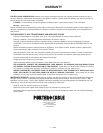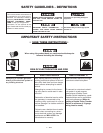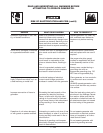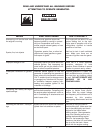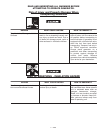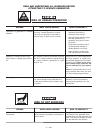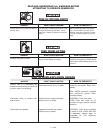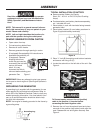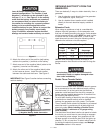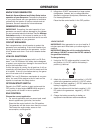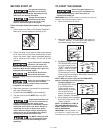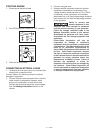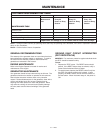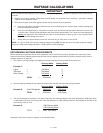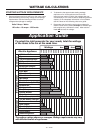
11 — ENG
Extension Cord Wire Gauge Chart
Amperage
*Up to 20 amp draw
Up to 30 amp draw
Cord
Length
0 to 100 ft.
0 to 100 ft.
Wire Gauge
Size
12 ga.
10 ga.
*NOTE: When amperage exceeds 20 amps; a 12
gauge extension cord should not be used for long dis-
tances.
Extension Cords
When using an appliance or tool at a considerable
distance from the generator, a 3-wire extension cord
that has a 3-blade grounding plug and a 3-slot recepta-
cle that accepts the tool's plug MUST be used in order
to reduce the risk of electrical shock. A cord of ade-
quate size must be used. Using the following chart to
determine the minimum wire size required.
An extension cord that is hot to the touch is
overloaded. Repair or replace damaged exten-
sion cords immediately.
Double Throw Transfer Switch
Potential hazards exist when a portable electric genera-
tor is connected to the main electrical supply coming
into the house. It is at that point that the electrical
generator could feed back into the utility company's
system causing possible electrocution of workers who
are repairing the electrical lines.
To avoid back feeding of electricity into utility systems,
a double-throw transfer switch must be installed
between the generator and utility power. The Double-
Throw Transfer Switch should be installed by a licensed
electrician and in compliance with all state and local
electrical codes. (When installing a Double-Throw
Transfer Switch, a minimum of 10 gauge wiring
must be used.)
The electrician should also install a sub-panel to isolate
the circuits you would want to use during an emergen-
cy or electrical power outage. Your generator will not
be large enough to handle the load of all the lights, ap-
pliances, TV, etc. at one time. To select which items to
run during the electrical power outage, see Wattage
Calculation section in this manual.
OBTAINING ELECTRICITY FROM THE
GENERATOR
There are basically 2 ways to obtain electricity from a
generator:
1. Use of extension cords directly from the generator
to the appliance, lights, tools, etc.
2. Use of a double-throw transfer switch installed
directly to the main electrical supply outside of
house.
Lawn & Garden batteries can come in two
terminal configurations. The Positive (+) and
Negative (-) terminals can be oriented so that
they are +/- or -/+. See Figure 5. In the unlikely
event that the battery terminals are unmarked,
we recommend that you return the battery to
the retailer for exchange for a properly marked
battery or let an authorized service center
install the battery for you. Failure to connect the
battery properly can possibly cause bodily
injury. In addition, extensive engine electrical
damage not covered under warranty can result.
6. Attach the other end of the positive (red) battery
cable to the positive (+) terminal on the battery.
7. Attach one end of the negative (black) cable to the
negative (-) terminal on the battery.
8. Attach the other end of the negative (black) cable
to the frame as shown. Install the star washer
between the cable and the frame. See Figure 6.
IMPORTANT: See Figure 5 caution before connecting
cable to battery.
Star
Washer
Negative
(-)
Battery
Cable
(-) Negative Battery Cable Connection
Figure 6
Figure 5



